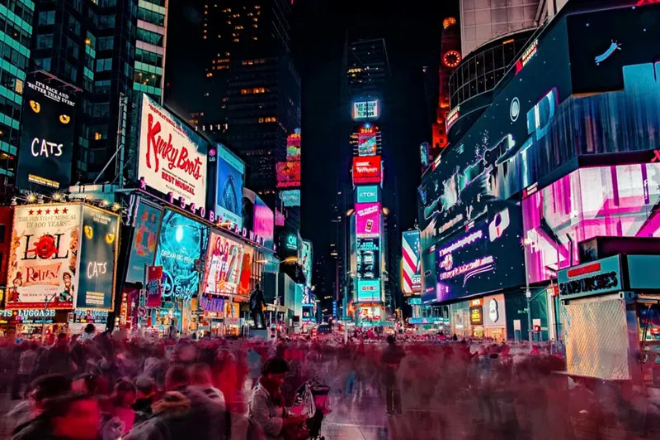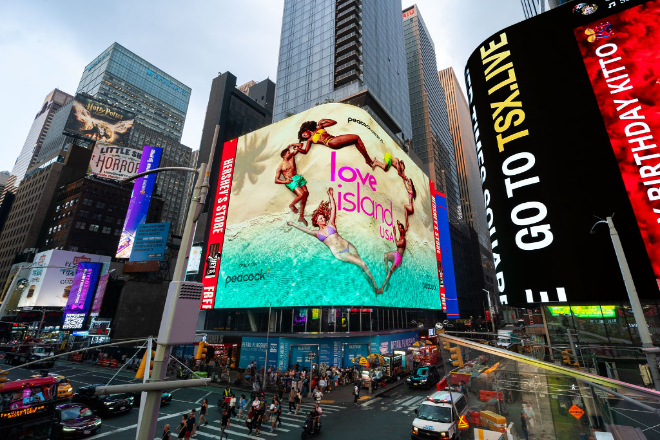소개

As cities become smarter and visual experience becomes more important, 대형 LED 스크린 have almost become the “standard” for squares. It can attract attention, publish information, and enhance the atmosphere.
But are all squares really suitable for installing it? The answer is not. As for why, let’s take a look at the content of the article.
목차
1. Advantages and application scenarios of large LED screens
1). Advantages of large LED screens
1.1). Super cool display effect:
Large LED screens have high brightness, which can be seen clearly even under the sun, and the colors are bright, which can present various realistic pictures, just like moving a colorful world in front of you. The viewing angle is also wide, no matter where you stand, you can see a clear picture.
1.2). Worry-free and environmentally friendly:
Its power consumption is relatively low, unlike some traditional screens that are “power-consuming,” and it has a long life, it is not easy to break after a long time of use, and it is also convenient to maintain.
Most importantly, it does not contain any harmful substances and is very environmentally friendly.
1.3). Flexible and changeable:
Screens of various sizes, shapes and resolutions can be customized according to different needs, and remote control and real-time updates can be achieved.
2). 애플리케이션 시나리오
2.1). Advertising:
Large LED display screens are like a huge “billboard” that can display various dynamic advertisements to attract the attention of passers-by.
For example, in New York’s Times Square, those super-large LED screens play advertisements of various brands, allowing brands to show up in places with huge traffic and increase their popularity.
2.2). Public information release:
It can be used to release weather forecasts, news information, emergency notices and other information, so that people can get various important information in time outdoors.
2.3). Event display:
In large-scale events, performances, and live broadcasts of sports events, large LED displays can bring immersive visual experiences to the audience. For example, in 경기장, the audience can clearly see every detail of the game through the large screen.
2.4). Urban landscape enhancement:
By playing high-definition videos and animations, large LED displays can add a sense of modernity and technology to squares and streets, becoming a new highlight of the city.
2. Adaptability analysis of different types of plazas

1). Commercial plaza
1.1). 장점:
- Attracting customers:
Commercial plazas are places for doing business. Large LED screens are like a super-large “signboard” that can display various advertisements, new products, and promotional activities.
For example, a large screen is placed at the entrance of a 쇼핑몰 to display advertisements for new clothes. Customers can see it at a glance and are directly attracted to the store.
- Improving grade:
A good large screen can make a commercial plaza look more high-end. For example, the large screens in some high-end shopping malls play high-definition fashion blockbusters.
When customers are shopping, it feels like they are watching a small fashion show, and the grade of the entire shopping mall has been improved.
2). Municipal Square
2.1). Functional requirements:
- Gatherings and activities:
Municipal Squares often have government gatherings and celebrations.
For example, on National Day and Party Founding Day, the large screen can broadcast the activity images in real-time so that everyone in the square can see them.
If there is no large screen, people standing in the back may not be able to see clearly.
- 정보 공개:
The government can also release any important notices and policy propaganda through the large screen.
For example, during the epidemic prevention and control period, epidemic prevention knowledge can be broadcast through the large screen, and everyone can see it, and the communication efficiency is very high.
2.2). Environmental coordination:
- Style unification:
Municipal squares are generally solemn, and the design of the large screen should not be too fancy.
For example, the square is surrounded by ancient buildings, and if the large screen is designed like something in a science fiction movie, it will look very abrupt.
The color and shape of the large screen should be consistent with the overall style of the square. Otherwise, it will destroy the solemnity of the square.
- Do not destroy the overall sense:
The location of the large screen installation is also critical, and it cannot destroy the overall layout of the square.
For example, the large screen cannot be placed in the middle of the square to block everyone’s sight or affect the passage of the square.
3). Cultural Square
3.1). Cultural conflict:
- Style mismatch:
Cultural squares are mainly places to display culture and art. If the large screen is designed too modern, such as being full of neon effects and dynamic advertisements, it will conflict with the traditional cultural style.
For example, in some quaint cultural squares, a very modern large screen suddenly appears, which will make people feel very inconsistent.
3.2). Content management:
- Strict review:
The content of the large screen in the cultural square must be strictly controlled. It is not allowed to play vulgar, violent content or things that are not related to culture. For example, some places have complained about large screens that play some spoof content.
- 문화 홍보:
The big screen can be used to promote local cultural characteristics. For example, playing some videos of intangible cultural heritage and traditional handicrafts can not only attract tourists but also pass on culture.
4). Community Square
4.1). Residents’ needs:
- Practicality:
Community squares are mainly for serving community residents, so the content of the big screen should be close to the lives of residents.
For example, some aerobics and parent-child activities can be played to make residents feel useful. If commercial advertisements are played every day, residents may not be willing.
- 정보 보급:
The big screen can also be used to spread community information, such as notifying community activities and property announcements.
For example, if the community wants to organize a garbage classification publicity activity, it will be very effective to notify residents in advance through the big screen.
4.2). Functional balance:
- Avoid interference:
While meeting the needs of community activities, it is necessary to avoid the negative impact of the big screen on the lives of residents.
For example, the big screen cannot be installed directly opposite the residential building, and the sound cannot be too loud; otherwise, it will affect the rest of the residents.
- 유연한 조정:
The content and usage time of the big screen can be flexibly adjusted according to the needs of community residents.
For example, if there are activities in the community on weekends, the large screen can play more videos related to the activities; at other times, it can play some public service advertisements or community notices.
In short, large LED screens have their own advantages and problems in different types of squares. The key is to install and use them reasonably according to the characteristics of the square and the needs of residents. It cannot be generalized, and specific analysis is required.
3. Decision factors and evaluation criteria for whether to install large LED screens in the square
1). Functional positioning of the square
1.1). Commercial square:
If the square is mainly used for business and attracting customers, then the large LED screen is definitely a “killer.”
For example, outside some shopping malls, the large screen plays various brand advertisements and new product launch information, and customers can be attracted at a glance.
Moreover, a good large screen can make the entire square look more upscale, just like putting a “high-tech coat” on the square. However, if the main function of the square is not business, then you have to think about it carefully.
1.2). Municipal square:
This type of square often has government gatherings and celebrations, and large LED screens can be of great use.
For example, during the National Day military parade, the big screen broadcasts the images in real time, so that everyone in the square can see them, and the atmosphere is particularly good.
But if the square is mainly used to hold some quiet cultural activities, the big screen may not be suitable.
1.3). Cultural Square:
The focus of the cultural square is to display culture and art. If a large LED display is installed, it may be a bit “obtrusive.”
For example, in the cultural squares next to some ancient buildings, if the large screen is designed too modern, it will destroy the overall cultural atmosphere.
However, if the content is to display cultural activities and art exhibitions, it is another matter.
1.4). Community Square:
The community square mainly serves community residents. If a large LED display is installed, if the content is closely related to the lives of residents, such as issuing community notices and promoting garbage classification, it is quite useful.
However, if all the content is commercial advertisements, it may cause residents to be disgusted.
2). Surrounding environment and residents’ needs
2.1). Architectural style:
The design of the display must be “in tune” with the architectural style around the square. For example, next to ancient buildings, the large screen cannot be designed too fancy or too modern, otherwise it will appear very abrupt.
Just like installing a large screen with flashing neon lights next to the Forbidden City, that is definitely not okay.
2.2). Ecological environment:
The impact of the display screen on the surrounding ecological environment should be considered.
For example, light pollution. If the large screen is facing the residential building, it will be too bright at night, which will definitely affect the residents’ rest.
According to relevant regulations, it is prohibited to install a display screen within 100 meters in front of the residential building and facing the window; the brightness should also be reduced to 150 meters.
2.3). Residents’ opinions:
Before installing the large screen, be sure to listen to the opinions of the surrounding residents. You can hold a residents’ meeting or send a questionnaire to see what everyone thinks.
If most residents think that the large screen will affect their lives, then the installation plan should be reconsidered. After all, the square belongs to everyone, and we cannot only consider the interests of the developer or the management.
3). Technology and equipment selection
3.1). Low 명도 and low energy consumption:
Choosing a low-brightness and low-energy display screen can reduce the impact on the environment and reduce operating costs.
For example, some display screens now use new technologies, such as the 4.2V/4.5V promoted by Qiangli Jucai to replace the 5V switching power supply and also integrate intelligent energy-saving functions, which improves energy-saving efficiency by 45%-60%.
In this way, it is not only environmentally friendly but also saves a lot of electricity bills.
3.2). Environmentally friendly display screen:
Give priority to environmentally friendly display screens to reduce pollution to the environment.
After all, everyone is paying more and more attention to environmental protection now, and using environmentally friendly display screens can also reflect the “green concept” of the square.
3.3). Display effect:
Choose the appropriate display effect according to the actual needs of the square. For example, a commercial square may need a high-resolution, high-brightness display screen to attract customers.
While a cultural square pays more attention to color saturation and contrast, so as to better display cultural content.
4). Management and maintenance mechanism
4.1). Equipment maintenance:
Establish a complete equipment maintenance mechanism, regularly check the operating status of the display screen, and repair faults in time.
After all, if the large screen is broken, it will not only affect the use but also become a safety hazard. For example, regularly check the lines and clean the screen to ensure that the large screen can operate normally.
4.2). Content review:
Strictly manage the content of the display screen to ensure that it meets the functional positioning of the square and the needs of residents.
For example, in the cultural square, vulgar and violent content cannot be played; in the community square, the content should be close to the lives of residents and cannot be all commercial advertisements.
4.3). Light pollution control:
Through technical means, such as automatic brightness adjustment, control the brightness of the display screen to reduce light pollution.
For example, at night, the screen brightness is automatically adjusted according to the brightness of the surrounding environment, which can ensure the display effect without being dazzling.
5). Feasibility of alternative solutions
5.1). Small display screen:
If a large LED display screen is really not suitable, you can consider installing a small display screen. Although the display range of a small display screen is limited, it has less impact on the environment, and the installation cost is also low.
For example, in a community square, several small display screens can be installed in different locations, which can meet the needs of information release without having too much impact on the lives of residents.
5.2). Landscape lighting:
In a leisure square or community square, similar functions can be achieved through landscape lighting.
For example, installing some uniquely shaped lighting around the square can not only beautify the environment but also not be as dazzling as a large screen.
Moreover, landscape lighting can also create different atmospheres, such as romantic and warm, making the square more distinctive.
In short, when deciding whether to install a large LED display, it is necessary to comprehensively consider factors such as the functional positioning of the square, the surrounding environment, the needs of residents, technical equipment, management and maintenance mechanisms.
We cannot only look at the immediate interests but also consider the long-term impact.
Only in this way can we ensure that the installation and use of the display not only meet the functional needs of the square but also have no negative impact on the surrounding environment and residents’ lives.
4. 사례 분석
1). New York Times Square:
There are many large LED displays here, such as the 1,600㎡ L-shaped display created by Sansi, and the 900+㎡ naked eye 3D display of Yuanheng Optoelectronics.
These screens not only display advertisements of various brands, but also often cooperate with roadshows and flash events to attract a large number of tourists and citizens.
Their success lies in taking advantage of the huge flow of people and the global influence of Times Square to spread brands and information further.
2). The Bund in Shanghai:
The 6-square-meter P3.91-pitch full-color LED screen on the Bund is not large in area, but it is in an excellent location.
It not only displays commercial advertisements, but also plays Shanghai’s city image promotional videos and historical and cultural stories, which not only enhances commercial value but also spreads urban culture.
5. 결론
Not every square is suitable for installing a large LED display. Whether to install it depends on the function of the square, the environmental characteristics and the real needs of people.
Only when the large screen is used in the right place and in the right way can it really play its role and make the urban space better and more valuable.
마지막으로 LED 디스플레이에 대해 더 알고 싶으시다면, 우리에게 연락해주세요.
